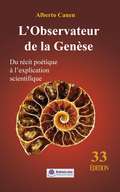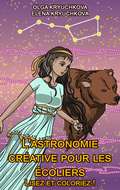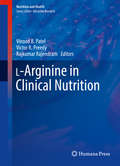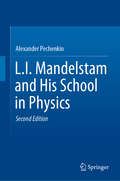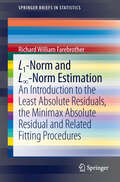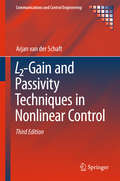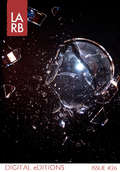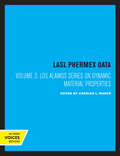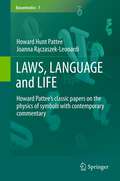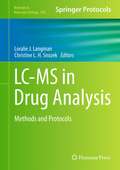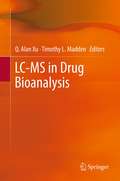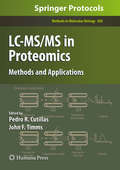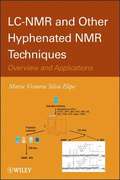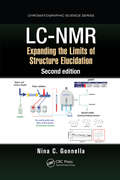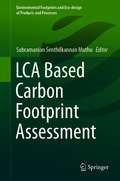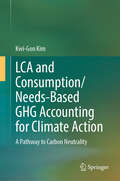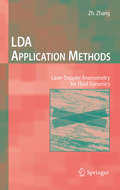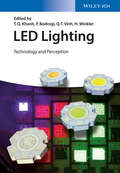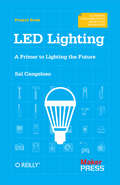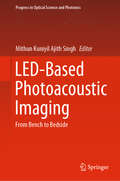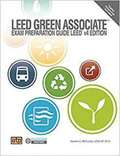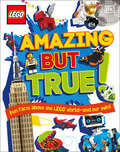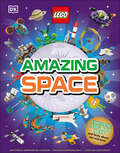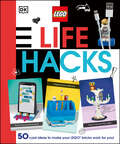- Table View
- List View
L'OBSERVATEUR DE LA GENÈSE - Du récit poétique à l'explication scientifique
by Alberto Canen Sophia BisstouanePlus de 300 000 livres vendus en anglais et en espagnol. La Genèse, les 7 jours, la Création... D'où provient le texte qui compose la première partie de la Bible ? Le texte de la Genèse n’est-il qu’un poème d'introduction... ou serait-ce un récit ? Qu'il y a-t-il derrière les mots de la Genèse ? Alberto Canen a trouvé une voie alternative pour répondre à ces questions et à d'autres, également contenues dans la Genèse. Il a trouvé un itinéraire que personne n’avait encore jamais suivi jusqu'ici. Il invite le lecteur à parcourir cet itinéraire et à prendre conscience avec lui de ses découvertes. L'auteur a découvert que, caché au fond de l'intrigue, il y avait quelqu'un. Quelqu'un qui observe, quelqu'un qui raconte, quelqu'un qui raconte ce qu'il observe. Et un emplacement, le lieu d’où il observe. La localisation de l'observateur. La clé d'un puzzle passionnant. La Genèse a été un mystère pendant des milliers d'années. Il était impossible de comprendre de quoi parlait le texte. S’il ne s’agissait que d’un poème d'introduction aux Saintes Écritures, ou s'il contenait réellement des informations sur la Création. Le texte de la Genèse a divisé les créationnistes et les scientifiques, durant très longtemps et cela jusqu’à aujourd’hui. Avec ce livre, j'espère que cette séparation entre scientifiques et créationnistes se diluera grâce à ma découverte de la clé unissant ces deux mondes. Je crois que la clé du mystère de la Genèse est de comprendre qu'elle est racontée par quelqu'un, un narrateur de la Genèse. Celui qui observe la vision que Dieu lui a confiée et qui à partir de là, raconte ce qu'il observe et il observe cela depuis une localisation humaine et terrestre. Cet endroit terrestre et précis est la clé pour comprendre la Genèse.
L'astronomie créative pour les écoliers. Lisez et coloriez !
by Olga Kryuchkova Elena KryuchkovaCe livre traite d'astronomie. Vous vous demandez ce qu'est l'astronomie ? L'astronomie est la science des objets cosmiques et des phénomènes célestes, l'étude de l'univers dans lequel nous vivons et de sa nature. Les astronomes font leurs recherches avec des télescopes dans d'immenses observatoires et avec des satellites en orbite autour de la terre. Les télescopes peuvent être lancés sur des fusées pour étudier la haute atmosphère et sur des aérostats non habités. Et certains véhicules et instruments peuvent même être lancés à bord de vaisseaux spatiaux pour explorer l'espace lointain. L'astronomie peut être professionnelle ou amateur. Les astronomes professionnels explorent le Soleil et le système solaire, la Voie lactée (où se trouve notre système solaire) et l'Univers en dehors de notre galaxie. Les astronomes professionnels forment également des étudiants dans l'enseignement supérieur et travaillent dans des observatoires. Les astronomes amateurs sont passionnés par l'astronomie en tant que passe-temps. Parfois, les astronomes amateurs peuvent se réunir dans des clubs où ils tiennent des réunions thématiques. Et ils observent différentes constellations, des éclipses solaires, etc. Dans ce livre, vous découvrirez notre planète Terre et son satellite, la Lune, d'autres planètes du système solaire et un certain nombre de constellations. Vous pourrez non seulement obtenir des informations utiles, accessibles et intéressantes, mais aussi colorier des illustrations en noir et blanc de l'image mythologique de telle ou telle planète, ou constellation. Ce livre est écrit dans un langage simple et accessible et s'adresse aux écoliers et collégiens. Il peut être utilisé comme matériel pédagogique supplémentaire dans le cadre scolaire.
L-Arginine in Clinical Nutrition
by Victor R. Preedy Vinood B. Patel Rajkumar RajendramThistext presents the application of current nutritional knowledge by physiciansand dietitians and incorporates emerging fields of science and importantdiscoveries. It contains seven major sections. Section 1: Basic Processes at the Cellular Levels, Section 2: ArginineMetabolism and Functions, Section 3: Arginine Status in Cells Related to OrganDamage and Disease, Section 4: Arginine Status and Use in Healthy Individuals, Section5: Arginine and Diseases of the Gastrointestinal Tract, Section 6: Therapeuticuses of Arginine: Diabetes, Obesity and Cardiovascular Diseases and Section 7: Therapeutic Uses of Arginine: Cancer, WoundHealing and Infectious Disease. Writtenby authors of international and national standing, leaders in the field andtrendsetters, Arginine in Clinical Nutrition is essential reading fornutritionists and dietitians, public health scientists, doctors,epidemiologists, health care professionals of various disciplines, policymakers and marketing and economic strategists.
L.I. Mandelstam and His School in Physics
by Alexander PechenkinThis biography of the famous Soviet physicist Leonid Isaakovich Mandelstam (1889–1944), who became a Professor at Moscow State University in 1925 and an Academician (the highest scientific title in the USSR) in 1929, describes his contributions to both physics and technology. It also discusses the scientific community that formed around him, commonly known as the Mandelstam School. By doing so, it places Mandelstam’s life story in its cultural context: the context of German University (until 1914), the First World War, the Civil War, and the development of the Socialist Revolution (until 1925) and the young socialist country. The book considers various general issues, such as the impact of German scientific culture on Russian science; the problems and fates of Russian intellectuals during the revolutionary and post-revolutionary years; the formation of the Soviet Academy of Science, the State Academy; and the transformation of the system of higher education in the USSR during the 1920s and 1930s. Further, it reconstructs Mandelstam’s philosophy of science and his approach to the social and ethical function of science and science education based on his fundamental writings and lecture notes. This reconstruction is enhanced by extensive use of previously unpublished archive material as well as the transcripts of personal interviews conducted by the author. The book also discusses the biographies of Mandelstam’s friends and collaborators: German mathematician and philosopher Richard von Mises, Soviet Communist Party official and philosopher B.M.Hessen, Russian specialist in radio engineering N.D.Papalexy, the specialists in non-linear dynamics A.A.Andronov, S.E. Chaikin, A.A.Vitt and the plasma physicist M.A.Leontovich. This second, extended edition reconstructs the social and economic backgrounds of Mandelstam and his colleagues, describing their positions at the universities and the institutes belonging to the Academy of Science. Additionally, Mandelstam’s philosophy of science is investigated in connection with the ideological attacks that occurred after Mandelstam’s death, particularly the great mathematician A.D.Alexandrov’s criticism of Mandelstam’s operationalism.
L1-Norm and L∞-Norm Estimation
by Richard William FarebrotherThis monograph is concerned with the fitting of linear relationships in the context of the linear statistical model. As alternatives to the familiar least squared residuals procedure, it investigates the relationships between the least absolute residuals, the minimax absolute residual and the least median of squared residuals procedures. It is intended for graduate students and research workers in statistics with some command of matrix analysis and linear programming techniques.
L2-Gain and Passivity Techniques in Nonlinear Control
by Arjan SchaftThis standard text gives a unified treatment of passivity and L2-gain theory for nonlinear state space systems, preceded by a compact treatment of classical passivity and small-gain theorems for nonlinear input-output maps. The synthesis between passivity and L2-gain theory is provided by the theory of dissipative systems. Specifically, the small-gain and passivity theorems and their implications for nonlinear stability and stabilization are discussed from this standpoint. The connection between L2-gain and passivity via scattering is detailed. Feedback equivalence to a passive system and resulting stabilization strategies are discussed. The passivity concepts are enriched by a generalised Hamiltonian formalism, emphasising the close relations with physical modeling and control by interconnection, and leading to novel control methodologies going beyond passivity. The potential of L2-gain techniques in nonlinear control, including a theory of all-pass factorizations of nonlinear systems, and of parametrization of stabilizing controllers, is demonstrated. The nonlinear H-infinity optimal control problem is also treated and the book concludes with a geometric analysis of the solution sets of Hamilton-Jacobi inequalities and their relation with Riccati inequalities for the linearization. #65533; L2-Gain and Passivity Techniques in Nonlinear Control (third edition) is thoroughly updated, revised, reorganized and expanded. Among the changes, readers will find: #65533; updated and extended coverage of dissipative systems theory #65533; substantial new material regarding converse passivity theorems and incremental/shifted passivity #65533; coverage of recent developments on networks of passive systems with examples #65533; a completely overhauled and succinct introduction to modeling and control of port-Hamiltonian systems, followed by an exposition of port-Hamiltonian formulation of physical network dynamics #65533; updated treatment of all-pass factorization of nonlinear systems The book provides graduate students and researchers in systems and control with a compact presentation of a fundamental and rapidly developing area of nonlinear control theory, illustrated by a broad range of relevant examples stemming from different application areas.
LAPD '53
by James Ellroy Glynn MartinA remarkable portrait of &“true L.A. noir&” with archival photos from the Los Angeles Police Museum and text by legendary crime writer James Ellroy (Los Angeles Times). James Ellroy, the undisputed master of crime writing, has teamed up with the Los Angeles Police Museum to present a stunning text on 1953 L.A. While combing the museum&’s photo archives, Ellroy discovered that the year featured a wide array of stark and unusual imagery—and to accompany the pictures, he has written text to illuminate the crimes and law enforcement of the era. Ellroy offers context along with wild detail and rich atmosphere—this is the cauldron that was police work in the city of the tarnished angels seven decades ago, revealed in more than 80 duotone photos throughout the book. &“These crime images resemble the work of photographer Weegee, but, Ellroy argues, they&’re superior because they resist artistry; they were taken by police officers doing their jobs.&” —Chicago Tribune
LARB Digital Edition: A Legible Science
by Los Angeles Review of BooksWe're all prone to excess, even in discussions of excess, observes biologist and science writer Marlene Zuk. This year has been marked by another rainfall of books about humans destroying the environment in which they evolved, a few about the a priori Darwinian mismatch between humans and their so-called "natural" environments, and a great many more about the even greater mismatch between humans and their constructed environments. This month's Digital Edition gathers some of the best essays and reviews from LARB's Science Section that deal with aspects of the mismatch, and how scientific discoveries and agendas are changing how we think about them. Several also deal with issues of legibility -- how science goes about making legible human experience, not to mention environmental impacts. From the exploding fields of neuroscience and genetics to reading the movement of glaciers, this month's selection of articles is the perfect match for readers in search of a legible science.
LASL Phermex Data, Vol. III (Los Alamos Scientific Laboratory Series on Dynamic Material Properties)
by Charles L. MaderThis title is part of UC Press's Voices Revived program, which commemorates University of California Press’s mission to seek out and cultivate the brightest minds and give them voice, reach, and impact. Drawing on a backlist dating to 1893, Voices Revived makes high-quality, peer-reviewed scholarship accessible once again using print-on-demand technology. This title was originally published in 1980.
LAWS, LANGUAGE and LIFE
by Howard Hunt Pattee Joanna Rączaszek-LeonardiHoward Pattee is a physicist who for many years has taken his own path in studying the physics of symbols, which is now a foundation for biosemiotics. By extending von Neumann's logical requirements for self-replication, to the physical requirements of symbolic instruction at the molecular level, he concludes that a form of quantum measurement is necessary for life. He explains why all non-dynamic symbolic and informational controls act as special (allosteric) constraints on dynamical systems. Pattee also points out that symbols do not exist in isolation but in coordinated symbol systems we call languages. Such insights turn out to be necessary to situate biosemiotics as an objective scientific endeavor. By proposing a way to relate quiescent symbolic constraints to dynamics, Pattee's work builds a bridge between physical, biological, and psychological models that are based on dynamical systems theory. Pattee's work awakes new interest in cognitive scientists, where his recognition of the necessary separation--the epistemic cut--between the subject and object provides a basis for a complementary third way of relating the purely symbolic, computational models of cognition and the purely dynamic, non-representational models. This selection of Pattee's papers also addresses several other fields, including hierarchy theory, artificial life, self-organization, complexity theory, and the complementary epistemologies of the physical and biological sciences.
LC-MS in Drug Analysis
by Loralie J. Langman Christine L. SnozekLiquid-Chromatography-Mass-Spectrometry procedures have been shown to be successful when applied to drug development and analysis. LC-MS in Drug Analysis: Methods and Protocols provides detailed LC-MS/MS procedures for the analysis of several compounds of clinical significance. The first chapters provide the reader with an overview of mass spectroscopy, its place in clinical practice, its application of MS to TDM and toxicology, and the merits of LC-MS(/MS) and new sample preparation techniques. The following chapters discuss different approaches to screening for drugs of abuse and for general unknowns, as well as targeted measurement of specific analytes or classes of analytes including abused drugs, toxic compounds, and therapeutic agents. Written in the successful Methods in Molecular BiologyTM series format, chapters include introductions to their respective topics, lists of the necessary materials and reagents, step-by-step, readily reproducible protocols, and notes on troubleshooting and avoiding known pitfalls. Authoritative and easily accessible, LC-MS in Drug Analysis: Methods and Protocols seeks to serve both professionals and novices with its well-honed methodologies.
LC-MS in Drug Bioanalysis
by Q. Alan Xu Timothy L. MaddenClinical pharmacology plays an important role in today's medicine. Due to the high sensitivity, selectivity, and affordability of a mass spectrometer (MS), the high performance liquid chromatography - mass spectrometry (LC-MS) analytical technique is widely used in the determination of drugs in human biological matrixes for clinical pharmacology. Specifically, LC-MS is used to analyze: anticancer drugs antidementia drugs antidepressant drugs antiepileptic drugs antifundal drug antimicrobial drugs antipsychotic drugs antiretroviral drugs anxiolytic/hypnotic drugs cardiac drugs drugs for addiction immunosuppressant drugs mood stabilizer drugs This book will primarily cover the various methods of validation for LC-MS techniques and applications used in modern clinical pharmacology.
LC-MS/MS in Proteomics
by John F. Timms Pedro R. CutillasWith the development of new quantitative strategies and powerful bioinformatics tools to cope with the analysis of the large amounts of data generated in proteomics experiments, liquid chromatography with tandem mass spectrometry (LC-MS/MS) is making possible the analysis of proteins on a global scale, meaning that proteomics can now start competing with cDNA microarrays for the analysis of whole genomes. In LC-MS/MS in Proteomics: Methods and Applications, experts in the field provide protocols and up-to-date reviews of the applications of LC-MS/MS, with a particular focus on MS-based methods of protein and peptide quantification and the analysis of post-translational modifications. Beginning with overviews of the use of LC-M/MS in protein analysis, the book continues with topics such as protocols for the analysis of post-translational modifications, with particular focus on phosphorylation and glycosylation, popular techniques for quantitative proteomics, such as multiple reaction monitoring, metabolic labelling, and chemical tagging, biomarker discovery in biological fluids, as well as novel applications of LC-MS/MS. Written in the highly successful Methods in Molecular BiologyTM series format, chapters include introductions to their respective subjects, lists of necessary materials and reagents, step-by-step, readily reproducible laboratory protocols, and notes on troubleshooting and avoiding known pitfalls. Comprehensive and cutting-edge, LC-MS/MS in Proteomics: Methods and Applications presents the techniques and concepts necessary in order to aid proteomic practitioners in the application of LC-MS/MS to essentially any biological problem.
LC-NMR and Other Hyphenated NMR Techniques
by Maria V. Silva ElipeThis practical guide provides a basic overview of the pros and cons of NMR spectroscopy as both a hyphenated and non-hyphenated technique. The book begins with a description of basic NMR concepts for the structural elucidation of organic compounds and then details the historical development of NMR and hyphenated NMR in the structural elucidation world, followed by applications of hyphenated NMR as LC-NMR and LC-MS-NMR in industry and academia. It also contains updated information on the latest advancements and applications of LC-NMR in such areas as degradation products, drug metabolism, food analysis, and drug discovery. An essential resource for scientists in industry and academia who work in the areas of organic chemistry, medicinal chemistry, process chemistry, and analytical chemistry.
LC-NMR: Expanding the Limits of Structure Elucidation (Chromatographic Science Series)
by Nina C. GonnellaThe isolation and structural characterization of substances present at very low concentrations, as is necessary to satisfy regulatory requirements for pharmaceutical drug degradants and impurities, can present scientific challenges. The coupling of HPLC with NMR spectroscopy has been at the forefront of cutting-edge technologies to address these issues. LC-NMR: Expanding the Limits of Structure Elucidation presents a comprehensive overview of key concepts in HPLC and NMR that are required to achieve definitive structure elucidation with very low levels of analytes. Because skill sets from both of these highly established disciplines are involved in LC-NMR, the author provides introductory background to facilitate readers’ proficiency in both areas, including an entire chapter on NMR theory. The much-anticipated second edition provides guidance in setting up LC-NMR systems, discussion of LC methods that are compatible with NMR, and an update on recent hardware and software advances for system performance, such as improvements in magnet design, probe technology, and solvent suppression techniques that enable unprecedented mass sensitivity in NMR. This edition features methods to quantify concentration and assess purity of isolated metabolites on the micro scale and incorporates computational approaches to accelerate the structure elucidation process. The author also includes implementation and application of qNMR and automated and practical use of computational chemistry combined with QM and DFT to predict highly accurate NMR chemical shifts. The text focuses on current developments in chromatographic-NMR integration, with particular emphasis on utility in the pharmaceutical industry. Applications include trace analysis, analysis of mixtures, and structural characterization of degradation products, impurities, metabolites, peptides, and more. The text discusses novel uses and emerging technologies that challenge detection limits as well future directions for this important technique. This book is a practical primary resource for NMR structure determination—including theory and application—that guides the reader through the steps required for isolation and NMR structure elucidation on the micro scale.
LCA Based Carbon Footprint Assessment (Environmental Footprints and Eco-design of Products and Processes)
by Subramanian Senthilkannan MuthuThis book discusses the concepts, methods and case studies pertaining to Life Cycle Assessment (LCA) based Carbon Footprint Assessment. It covers chapters on Carbon Footprint Assessment with LCA methodology & case studies on carbon footprint calculation following the LCA approach on power plants in India, Impacts of Vehicle Incidents On CO2 Emissions and school buildings in India.
LCA and Consumption/Needs-Based GHG Accounting for Climate Action: A Pathway to Carbon Neutrality
by Kwi-Gon KimThis book reveals causes of the GHG emission accounting practice failure over the last several decades, describes evolution of new tenets of the accounting and remaining tasks, and suggests a new comprehensive integrated accounting in the form of protocol. The latest Intergovernmental Panel on Climate Change (IPCC) assessment report calls for net zero CO2 emissions by 2050 to limit warming to 1.5 degree C. As a result, many countries, cities, and industries are putting forward their greenhouse gas (GHG) emission reduction actions and commitments. But can the countries, cities, and industries meet these ambitious decarbonization goals without a reliable GHG inventory? This book tries to answer this question. It has been argued that there is a need to include LCA and consumption/needs-based GHG emissions as a complimentary indicator to the current approach of production-based GHG accounting emissions. As a shifting of the focus of accounting system after the Paris Agreement, consumption/needs-based approach is newly focused on a more broader accounting approach for NDCs and LDCs with a vision of all of society approach. Traditional national inventory approach to GHG emission accounting has been severely criticized as being too production process-oriented, sector-based approach, less transparent, a lack of public participation, no considerations for human needs and human factors.
LDA Application Methods
by Zhengji ZhangThis technical book considers the application side of LDA techniques. Starting from the basic theories that are crucial for each LDA user, the main subject of the book is focused on diverse application methods. In details, it deals with universal methodical techniques that have been mostly developed in the last 15 years. The book thus gives for the first time an application reference for LDA users in improving the optical conditions and enhancing the measurement accuracies. It also provides the guidelines for simplifying the measurements and correcting measurement errors as well as for clarifying the application limits and extending the application areas of LDA techniques. Beside the treatments of some traditional optical and flow mechanical features influencing the measurement accuracies, the book shows a broad spectrum of LDA application methods in the manner of measuring the flow turbulence, resolving the secondary flow structures, and quantifying the optical aberrations at measurements of internal flows etc.. Thus, it also supports the further developments of both the hard- and software of LDA instrumentations.
LED Lighting
by Q. T. Vinh H. Winkler P. Bodrogi T. Q. KhanPromoting the design, application and evaluation of visually andelectrically effective LED light sources and luminaires for generalindoor lighting as well as outdoor and vehicle lighting, this bookcombines the knowledge of LED lighting technology with humanperceptual aspects for lighting scientists and engineers. After an introduction to the human visual system and currentradiometry, photometry and color science, the basics of LED chipand phosphor technology are described followed by specific issuesof LED radiometry and the optical, thermal and electric modeling ofLEDs. This is supplemented by the relevant practical issues ofpulsed LEDs, remote phosphor LEDs and the aging of LED lightsources. Relevant human visual aspects closely related to LEDtechnology are described in detail for the photopic and the mesopicrange of vision, including color rendering, binning, whiteness,Circadian issues, as well as flicker perception, brightness, visualperformance, conspicuity and disability glare. The topic of LEDluminaires is discussed in a separate chapter, including retrofitLED lamps, LED-based road and street luminaires and LED luminairesfor museum and school lighting. Specific sections are devoted tothe modularity of LED luminaires, their aging and the planning andevaluation methods of new LED installations. The whole is roundedoff by a summary and a look towards future developments.
LED Lighting: A Primer to Lighting the Future
by Sal CangelosoWe’re on the brink of a lighting revolution with light-emitting diodes—the tiny LEDs you’ve seen in electronic devices for years. With this practical guide, you’ll go behind the scenes to see how and why manufacturers are now designing LED devices to light everything from homes and offices to streets and warehouses.Author Sal Cangeloso shows you the working parts of a “simple” LED bulb and explains the challenges electronics companies face as they push LED lighting into the mainstream. You’ll learn how you can use LEDs now, and why solid state lighting will bring dramatic changes in the near future.Explore the drivers, phosphors, and integrated circuits in a typical LED bulbUnderstand the challenges in producing LED bulbs with acceptable brightness, color temperature, and power consumptionLearn about non-bulb LED applications, including lamps, street lights, and signageDiscover the market forces driving—and impeding—the adoption of LED lightingCompare LEDs to compact fluorescent lamps (CFLs) and electron-stimulated luminescence (ESL) bulbsGaze into the future of intelligent lighting, including networked lighting systems
LED-Based Photoacoustic Imaging: From Bench to Bedside (Progress in Optical Science and Photonics #7)
by Mithun Kuniyil Ajith SinghThis book highlights the use of LEDs in biomedical photoacoustic imaging. In chapters written by key opinion leaders in the field, it covers a broad range of topics, including fundamentals, principles, instrumentation, image reconstruction and data/image processing methods, preclinical and clinical applications of LED-based photoacoustic imaging. Apart from preclinical imaging studies and early clinical pilot studies using LED-based photoacoustics, the book includes a chapter exploring the opportunities and challenges of clinical translation from an industry perspective. Given its scope, the book will appeal to scientists and engineers in academia and industry, as well as medical experts interested in the clinical applications of photoacoustic imaging.
LEED Green Associate Exam Preparation Guide (v4 Edition)
by Heather C. McCombs<p>The LEED Green Associate Exam Preparation Guide, LEED v4 Edition is designed to help you pass the LEED Green Associate exam. The exam prep guide captures the critical points you need to know about green building. It also reflects the structure of the exam knowledge and task domains to organize foundational concepts in green building and LEED. <p>The exam prep guide will help you prepare for the exam by emphasizing key terms and providing application learning through practice questions. This resource is intended to be used in conjunction with the exam primary references, including the LEED Core Concepts Guide. Access to a variety of digital resources that enhance learning is also included with this guide.</p>
LEGO Amazing But True: Fun Facts About the LEGO World - and Our Own!
by Catherine Saunders Julia March Elizabeth DowsettAn eye-popping fact book with a LEGO twist – discover amazing information about the world around us with the help of LEGO minifigures and bricks! Did you know a Goliath spider weighs the same as 75 2x4 LEGO bricks? Or that LEGO bricks and minifigures in various forms have travelled to Saturn, Mars, and the International Space Station? And did you know the Taj Mahal gets a mud pack treatment to remove pollution stains? Or that hummingbirds are the only birds that fly backwards? From unbelievable space and nature facts, to mind-boggling inventions and technology trivia, children will be amazed and entertained with incredible information about the LEGO world and our own. ©2022 The LEGO Group.
LEGO Amazing Space: Fantastic Building Ideas and Facts About Our Amazing Universe
by Arwen HubbardDiscover the furthest frontiers of space – and learn to build the Universe’s most incredible sights!Explore the wonders of the Universe without even putting on a spacesuit! Take a tour of planets, stars, galaxies, and even alien worlds far away from Earth. Discover how the Big Bang created all the worlds that make up the Universe; find out what’s in a black hole and learn how stars are born and why they die. Go on a spacewalk, drive a Mars Rover, dock with the International Space Station, and launch a probe to make contact with extraterrestrials! With more than 150 out-of-this-world LEGO models to inspire you, what will you build?
LEGO Life Hacks: 50 Cool Ideas to Make Your LEGO Bricks Work for You!
by Julia MarchGet ready to hack your life, LEGO style!This ebook is bursting with more than 50 smart ideas to streamline your life and accessorize your space. You'll find stationery hacks help you organize your desk, cool ideas to make the most of your tech, and gadgets to blitz your boring chores. From a speaker that amplifies your phone, a weekly planner made of LEGO bricks, and a catapult that flings paper into the wastepaper basket, these ideas will make your LEGO bricks work for you. Discover ways to personalize your living space, from photo frames to brick-built houseplants, plus smart ways to display your favorite LEGO builds and minifigures. These creative ideas will inspire you to use your LEGO bricks in awesome new ways. With amazing images, easy to follow step-by-step instructions, and handy tips for further building, this ebook will take your building to the next level. ©2021 The LEGO Group.
